A Strawberry Hanging Basket Is An Elegant Way To Grow Fresh Fruit At Your Fingertips
Love strawberries but short on space? The solution is growing strawberries in hanging baskets. We'll show you how.

Amy Grant
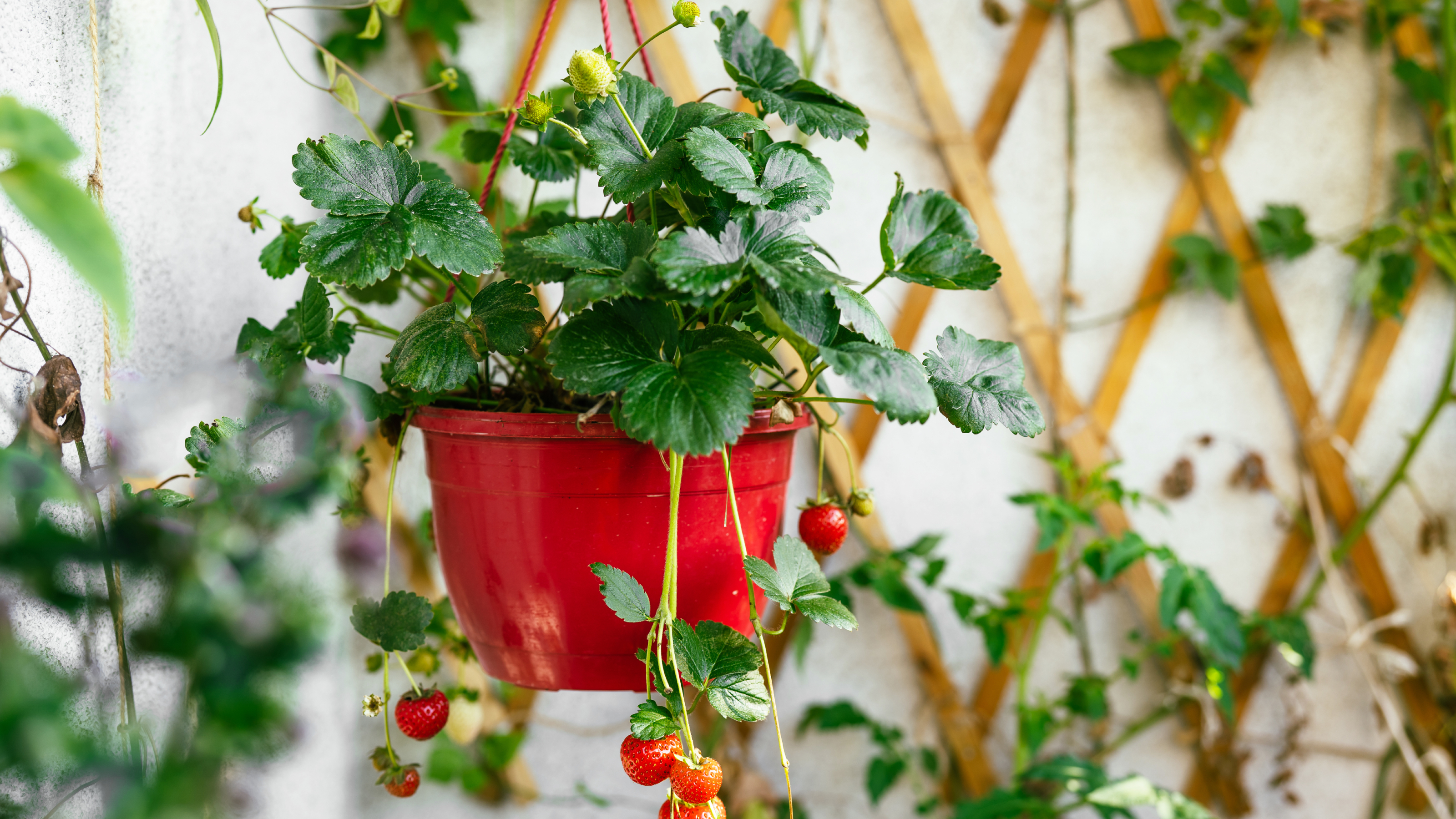
If you love strawberries but don't have the space to grow them, all is not lost. A strawberry hanging basket is the elegant, space-saving solution you need. With the proper care, a hanging planter full of strawberries will provide fresh, juicy fruit all summer long. Plus, the red berries and vining green foliage look lovely spilling out of a pot on your porch or balcony.
Growing strawberries in containers like hanging baskets is a simple and beautiful way to add more edible plants to your outdoor space. Let’s take a look at how to do it—and start dreaming of homemade strawberry shortcake!
Benefits of Strawberry Hanging Baskets
A hanging basket is an ideal environment for growing strawberries. It helps prevent insect infestations, soil borne diseases, and can even keep pesky wildlife at bay if you place your pot in the right location. Strawberries have a tendency to spread, so keeping them contained in hanging baskets stops them from becoming a nuisance in traditional garden beds.
The biggest benefit of growing strawberries in hanging baskets, however, is that even gardeners with small spaces can cultivate this quintessential summer fruit.
There are a few caveats to growing strawberry plants in hanging baskets, though. Strawberries need adequate light, soil, nutrition, and water to thrive. Plan on growing them as an annual since container plants will probably not survive the winter, unless you take special care to protect them. You also need to choose a day-neutral or everbearing strawberry variety that provides fruit in the same season.

Best Strawberry Varieties for Hanging Baskets
Choosing the right types of strawberry plants is key for growing successful hanging baskets. June-bearing strawberries are not good to grow as an annual because they are more labor intensive and produce a lot of runners. They bloom and fruit early, so to enhance their root system you must pinch off the first year’s blooms. If they are allowed to fruit the first June, the fruit will be small and inferior.
You can purchase strawberries at the garden center as live plants or mail order dormant bare-root plants. Choose one of the varieties below for delicious strawberries that grow well in hanging baskets.
Sign up for the Gardening Know How newsletter today and receive a free copy of our e-book "How to Grow Delicious Tomatoes".
Day-Neutral Varieties
To maximize fruit production for the season, choose a day-neutral variety. Day-neutral strawberry varieties bloom and fruit throughout the season.
If you live in an area with hot summers, day-neutral varieties will stop producing when temperatures exceed 90 degrees F (32 C), but will begin to produce again when the temperature drops in the fall.
Another benefit of this type is that they do not produce a lot of runners or offsets. Remove runners when you see them. Some day-neutral varieties that do well in hanging baskets are:
- Albion
- Seascape
- Cabrillo
- Everest
- San Andreas
- Monterey
- Tristar
- Tribute
- Mara des Bois
- Evie
Everbearing Varieties
Like day-neutral varieties, everbearing strawberries don't produce as many runners and offshoots. They don't produce as much fruit as day-neutral varieties, as they only fruit twice per growing season. Some varieties to try in hanging baskets include:
- Ozark Beauty
- Quinalt
- Fort Laramie
- Ogallala
- Pink Panda (pink flowers)
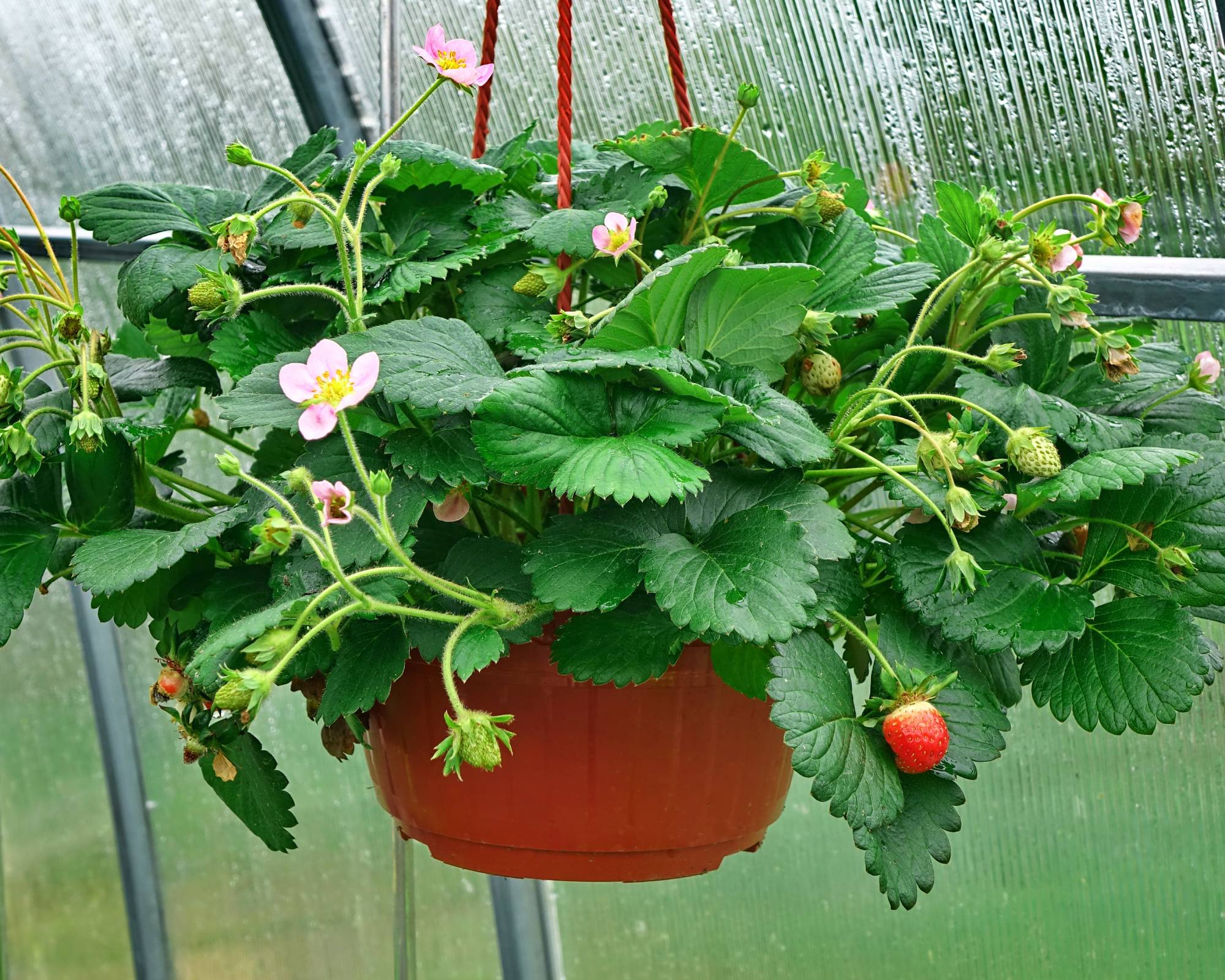
Alpine Varieties
Another possibility for hanging baskets is Alpine strawberries. These dense, compact plants produce small, fragrant, incredibly sweet berries. Alpine strawberries thrive in partial shade, so they are a good option for gardeners with limited sun. They produce fruit from spring through fall. Some of the best varieties for growing in baskets are:
- Mignonette
- Rugen Improved
- Yellow Wonder (yellow berries)
Any of these varieties will do beautifully as hanging basket strawberry plants. You can find Alpine strawberries in nurseries and online as plants or seeds.
How to Grow Hanging Basket Strawberries
Growing strawberry plants in hanging baskets begins with a large basket. Choose a container that is at least 12 inches (30 cm) wide and 8 to 10 inches (20 to 25 cm) deep to accommodate growing plants.
Well-draining soil is also very important. A good, commercial mix works well or you can make your own DIY potting mix. Combine two parts compost, two parts coco coir or some other peat alternative, and one part perlite or vermiculite.
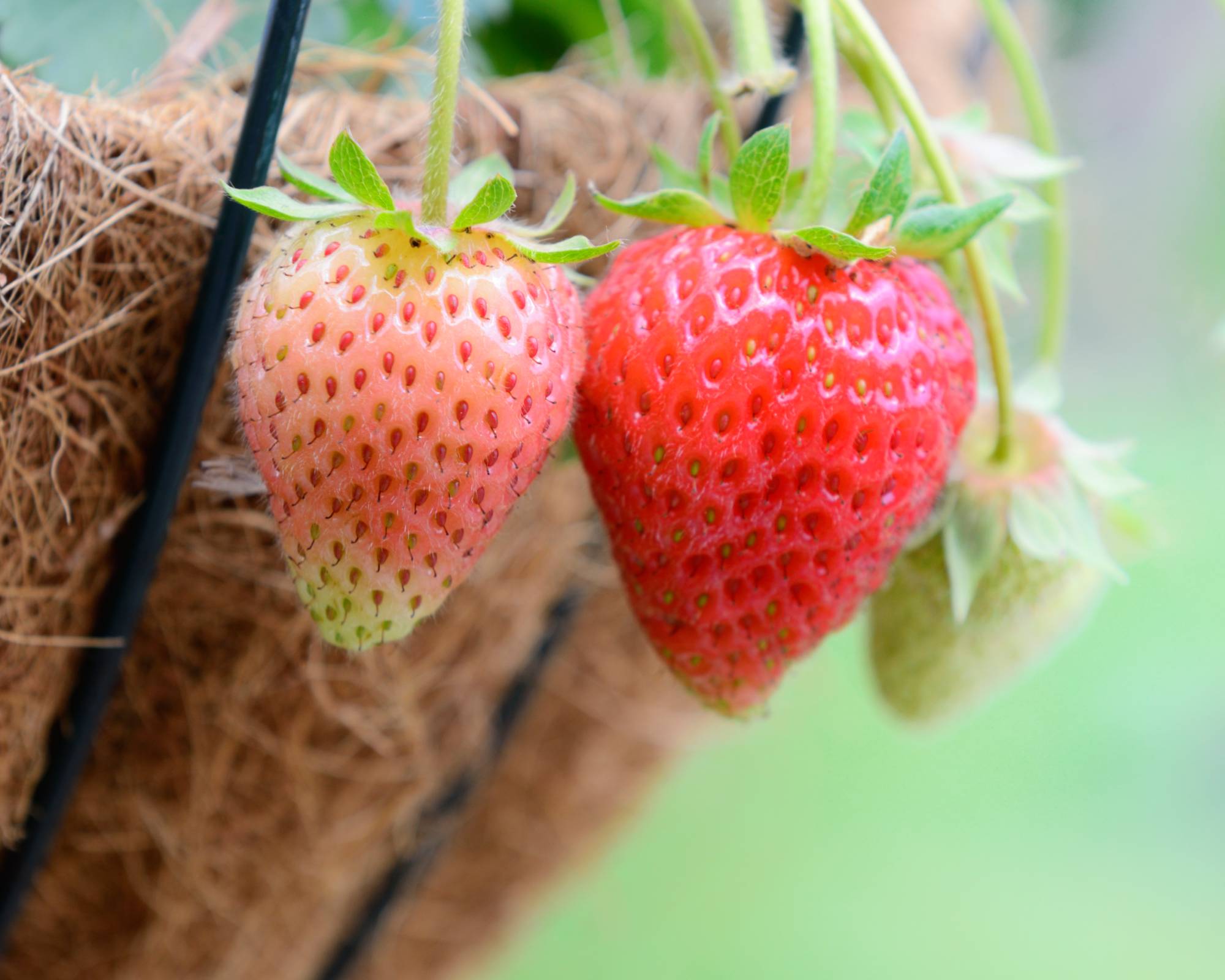
Planting
Plant your chosen strawberry varieties in early spring in your prepared containers. Place in the soil at the same height as they were in their nursery pots. Plants that are set too deeply may develop crown rot.
You can fit about four nursery sized plants in a 12 to 14 inch (30 to 36 cm) wide hanging basket. Strawberry plants typically grow 6 inches (15 cm) to 12 inches (30 cm) tall. Be sure to remove any runners that emerge.
Ideally, set the strawberry plants in the spring. If possible, locate hanging basket strawberries near spring blooming flowers that attract bees—a necessary pollinator for strawberries to set fruit. Position the hanging strawberry plants closer together than you would in the garden.
Fertilizing
If your potting mix does not contain fertilizer, add a balanced fertilizer such as 16-16-16 or 20-20-20 after planting. Strawberries are heavy feeders so fertilize two to three times during the season. Due to the rather limited amount of nutrients in the small planter, strawberry hanging baskets require regular fertilization—about once a month until blooming.
You can use either granular or liquid fertilizer. Granular fertilizers release the nutrients more slowly so you do not need to reapply this type as often as a liquid fertilizer. Follow the instructions on the package.
Watering & Mulching
Strawberry plants require consistent moisture but should not be saturated. Water when the top of the soil is dry. Check them daily because their shallow roots will dry out quickly. They may need water twice a day in warmer areas.
Mulch strawberry plants to help keep soil moist. But be careful not to spread any mulch on top of the crowns or rot may occur. Mulch also helps prevent disease by keeping fruit off the soil. When watering, try not to get the fruit wet to prevent strawberries rotting on the vine.
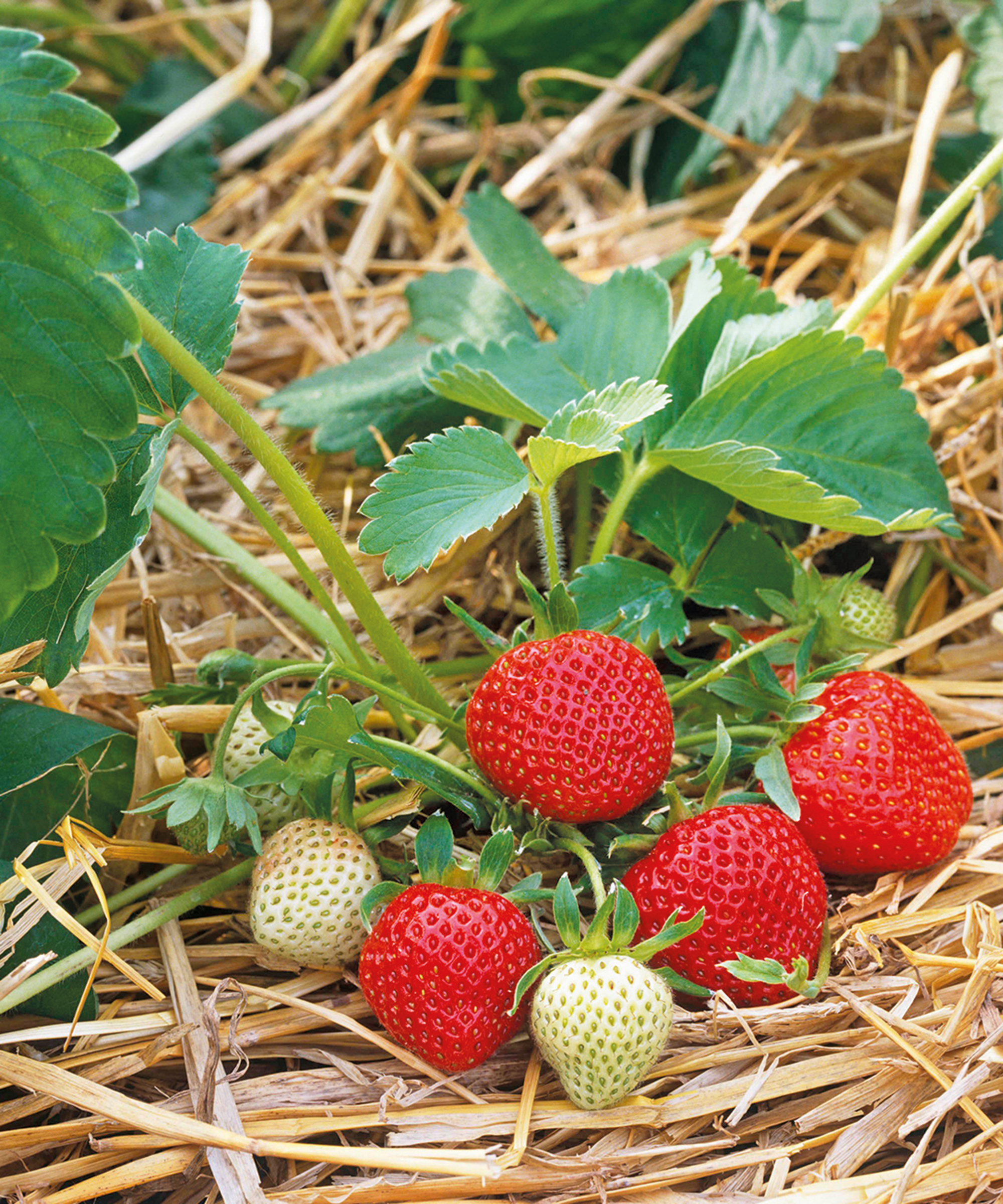
Problems, Pests & Diseases
To minimize disease, remove any leaves or fruit that look diseased to prevent it from spreading. Crown rot, leaf spot, and powdery mildew can be troublesome.
Hanging baskets will prevent some animal and insect invaders but birds will try to snatch the fruit. You can cover the plants with netting while they are ripening.
Harvesting
Hanging strawberry plants (except Alpine varieties) need a good six to eight hours of full sun a day for optimal fruit production. Pick the fruit when it is completely red. Leave the stem and cap attached to help fruit last longer.
You can harvest when the fruit is about 75 percent ripe and it will continue to ripen indoors. However, fruit left on the plants until completely ripe will taste better.
Overwintering & Repotting
Move the hanging strawberry garden to a sheltered area if heat is intense or frost or rainstorms are imminent. Freezing temperature can injure or kill strawberry plants, so bring containers indoors if frost is predicted in late spring or early fall. Winterizing potted strawberries this way will allow you to grow the same plants for more than one season.
Repot hanging strawberries each spring with fresh soil and enjoy the fruits of your labor for years to come—well, for at least three years. After that it may be time to invest in a new round of plants for your strawberry hanging baskets, but in the meantime, pass the whipped cream.
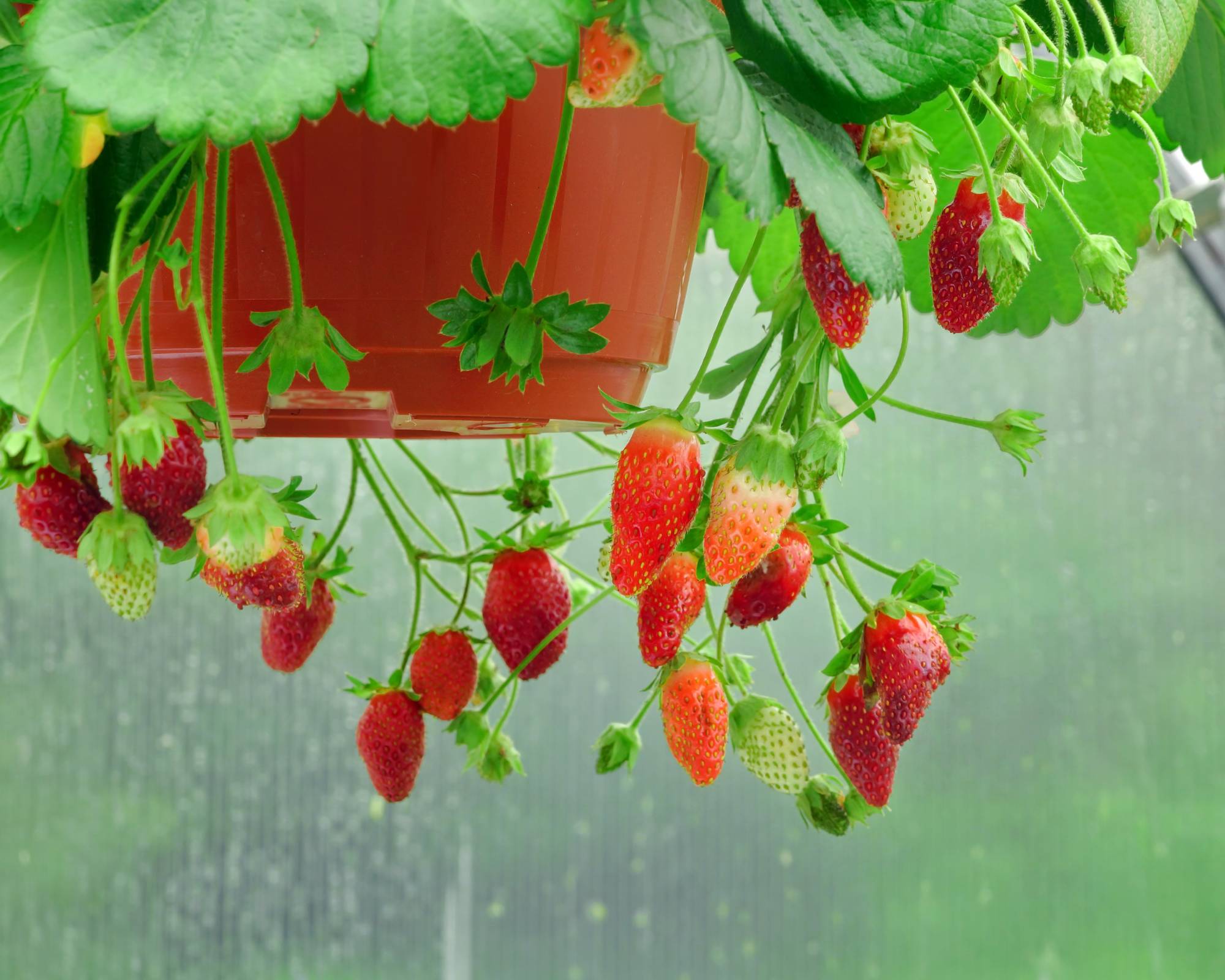
Grow an Entire Edible Garden in Containers
- Add blueberry plants to your container garden for even more fresh and tasty summer fruit at your fingertips!
- Grow tomatoes anywhere with these stylish Self-Watering Rolling Tomato Planters. After summer is done, roll them indoors to keep on growing!
- Harvest delicious produce on your patio for years to come! These 7 perennial vegetables are perfect for pots.
This article features products available from third party vendors on the Gardening Know How Shop.

After graduating from Oklahoma State University with a degree in English, Susan pursued a career in communications. In addition, she wrote garden articles for magazines and authored a newspaper gardening column for many years. She contributed South-Central regional gardening columns for four years to Lowes.com. While living in Oklahoma, she served as a master gardener for 17 years.
- Amy GrantWriter